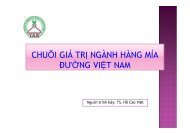TUYEÅN TAÄP
tuyeÃ¥n taäp - CHUYÃN TRANG GIá»I THIá»U CÃC GIá»NG MÃA Tá»T ...
tuyeÃ¥n taäp - CHUYÃN TRANG GIá»I THIá»U CÃC GIá»NG MÃA Tá»T ...
- No tags were found...
You also want an ePaper? Increase the reach of your titles
YUMPU automatically turns print PDFs into web optimized ePapers that Google loves.
Proc. S. Afr. Sug. Technol. Ass. (2001) 75, pp. 175-179<br />
AVAILABLE METHODS FOR ASSESSING VARIETAL<br />
RESISTANCE TO SUGARCANE STALK BORERS<br />
B VERCAMBRE 1 , R GOEBEL 2 , D CAO ANH 3 AND J ROCHAT 4<br />
1 CIRAD/CA, Programme canne à sucre, TA 71/09, 34398 - Montpellier Cedex 5, France<br />
2 South African Sugar Association Experiment Station, Private Bag X02, Mount Edgecombe, 4300, South Africa<br />
3 ISCR, Crop Protection Division, Ben Cat – Binh Duong, Vietnam<br />
4 CIRAD, Laboratoire d’entomologie, BP 20, 97408 - St-Denis Messageries Cedex 9, Réunion, France<br />
Abstract<br />
Sugarcane growing areas have a reasonably stable biological balance, and the<br />
use of chemicals to control stalkborers is undesirable. Varietal resistance could form<br />
an important component of an IPM strategy. In this paper, the main methods (field and<br />
laboratory) for assessing resistance to stalkborers are discussed, with some results<br />
obtained by the CIRAD team included.<br />
Introduction<br />
Sugarcane is semiperennial and produces considerable biomass, forming an<br />
ideal habitat for insects. Most insects do not affect crops, but some compete with<br />
humans for sugar and by-products. Sugarcane stalkborers are key pests of this crop<br />
worldwide because they feed directly on the vegetative tissues that store sucrose,<br />
allowing the introduction of micro-organisms that affect yield and quality. Conversely,<br />
the crop habitat permits the development of many beneficial arthropods that limit<br />
borers and keep other pests in check. The regular use of insecticides is often<br />
undesirable if natural enemies are to have maximum impact and other means have to<br />
be used to improve the control of borers. Varietal resistance might well be one of the<br />
most valuable methods for implementing an integrated pest management (IPM)<br />
strategy. For example, in the USA, predation and varietal resistance have been used<br />
with success for the120 management of the sugarcane borer Diatraea saccharalis<br />
(Bessin & Reagan, 1993). Similarly, this method is often favoured in studies carried<br />
out by the main sugarcane producing countries (Macedo et al.,1978; Leslie &<br />
Keeping, 1996; Allsopp et al., 1996; Mukunthan and Mohanasundaram, 1998;<br />
Kakakhel et al., 1999). This paper describes several methods for assessing varietal<br />
resistance, and results obtained by CIRAD entomologists with two commercial<br />
varieties (R570 and R579) are presented. Methods for assessing the different<br />
mechanisms of varietal resistance, as described by Painter (1968) are presented<br />
according to their use in the field or laboratory.<br />
Methods used in the field for overall evaluation of varietal resistance are<br />
discussed.<br />
Research station trials<br />
Insecticide trials with two varieties<br />
The difference in production between a plot protected by an insecticide and a plot<br />
subject to significant pest attack, may serve as a measure of resistance. Using this<br />
197






